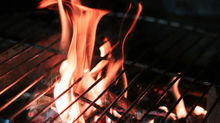Episode 29 Techniques for Cooking over an open fire
- Arlene Coco

- Jul 27, 2022
- 4 min read

The magic of fire will inspire you to think outside the pit.
When I had my outdoor kitchen built, my blacksmith installed a big fireplace with a trammel or swinging black hanging iron arm with notches in it so I could hang a black pot over the fire with ease and adjust the temperature by moving the pot to a different notch. This return to “no-tech” cooking has given me a new appreciation for cooking over open fires.
The secret of success is the vessel or the vehicle to bake it without incinerating it. There is a multitude of ways to cook over an open fire but the three that seem to be the easiest are cooking in a vessel like a black iron pot or a clay pot, a grill right over the flames and cooking right in the ashes, with the food wrapped in foil packets.
Techniques of perfection are easy to master.
If you are cooking for a crowd, the iron pot method enables you to feature a one-pot meal like tender beef or stew with caramelized root vegetables. Don’t get too complicated with the recipes, just use straightforward quality ingredients with lots of liquid to braise and tenderize the meat. If you buy a Dutch oven, I suggest purchasing one with a lip so you can stack hot coals on top. The ones with legs are more versatile because the heat can be evenly distributed under the pot.
Don’t forget to season your new Dutch oven by scrubbing with steel wool to remove the protective coating. Let it air dry and preheat your oven to 350F. After it’s dry place a thin layer of cooking oil and place it on the oven rack with the lid. Bake it for an hour or so. Repeat this process after pot is cool enough to handle. Never use soap in your oven or let it sit in water as it will strip the protective coating, rinse well with hot water, wipe out and place on top of the stove over low heat to dry. If your black iron cookware becomes rusty, repeat the above process to re-cure.
Tuscan Grill or Tripod Method
The grill method is popular in Italy and sometimes referred to as a Tuscan Grill. It is an iron grate like a grill that perches over the fire. It’s a great technique for grilling butterflied chickens or lamb chops. While the smoke flavor and charred bits yield a succulent dish, cooking over an uncontrolled flame, for the most part, is not for the faint of heart. It requires constant attention and turning when the fat falls and generates constant flare-ups. Why would you do this you ask for an expensive lamb chop? The smoke from the wood imparts a pungent flavor that can’t be replicated on a gas grill or charcoal. Plus, it’s a test to see if you really can pull off such a culinary feat. Start small with just simple burgers or boneless chicken. The Tuscan grill is made for thin, quick pieces of boneless meat like brochettes or chops that normally require only a quick cooking time. Tri-pods or sometimes called Spyders are a three-legged grill or trivets that hold your pot or meat over the flames. You can adjust the height and this is similar to the trammel method. I like to cook burgers and chapatti bread on a tri-pod, after the cooking is almost done, you can adjust away from the heat to keep things warm.
Cooking in Ashes
We all know about cooking in ashes from scouting days. Wrapping food in aluminum foil pouches and carefully placed in the ashes with hopes oven even heat distribution. This technique can be tricky if your heat source is uneven, but Mike Dean, a local food adventurer, and cookbook author loves this method for cooking local fish. “I cook a lot of native Red Fin Lake Trout” “They are delicious and not as fatty and oily as the Siskewit Lakers in Lake Superior” Dean explains. His recipe is simple- Cooked on top of the foil open or steam in a piece of foil rolled up like a Viking ship, the adds butter or olive oil and lemon juice, citrus pepper, the fresh ground cracked pepper, Paul Prudhomme’s blackened steak seasoning and dry summer savory, sliced fresh lemons and thinly sliced onions. After it’s cooked he drizzles the whole business with lemon-infused olive oil.
Sides become stars
Roasting onions in ashes is another good idea for beginners. Simply wrap a large sweet onion with the skin in a large sheet of heavy-duty aluminum foil and place right in the ashes. After 30 minutes, turn and cook about 30 minutes more. It’s done when the onion is soft. Pull the peeling off, let it cool and slice or chop into large chunks. Drizzle with olive oil and balsamic vinegar for a spectacular appetizer. Apples for side dishes can also work with this same method. Be sure to core them and add your favorite sweet spices before wrapping. Butter is optional since the apples will steam and provide its own juice.

The Tuscan Grill works great for outdoor cooking











































Comments